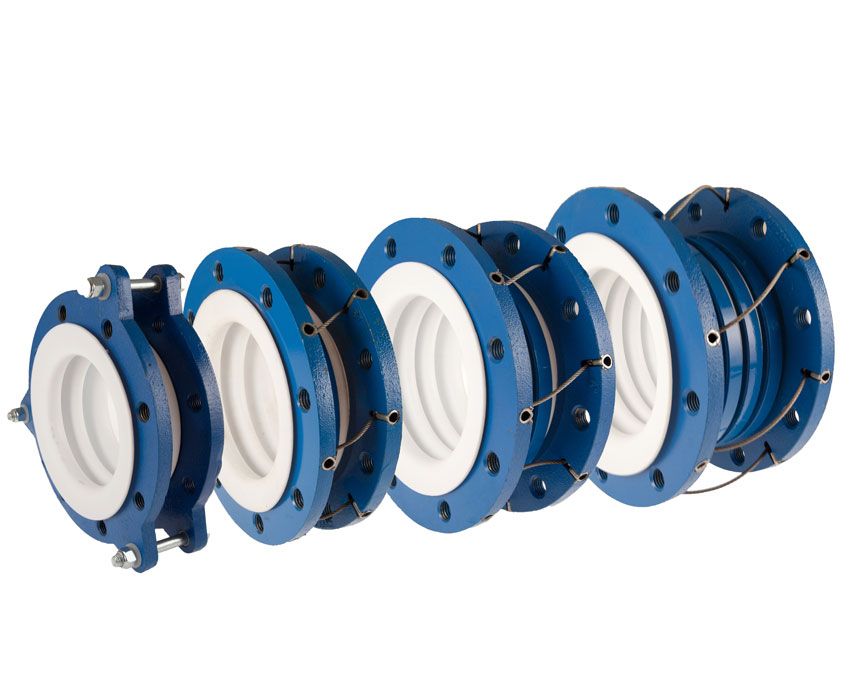Examining Teflon Expansion Joints and PTFE Multi-Layered Solutions’ Versatility
Teflon sometimes referred to as PTFE, is a well-known name that is closely associated with exceptional resistance to heat, chemicals, and corrosion. Because of these remarkable qualities, Teflon has become the best option when it comes to expansion joints and is now an essential part of pipe systems. Teflon expansion joints provide a well-balanced combination of strength and flexibility, allowing for improved mobility and vibration absorption. Consequently, this leads to a significant increase in the longevity and general efficiency of industrial systems.
Examining Teflon Expansion Joints’ Particular Benefits:
- Chemical Resistance That Is Unmatched: Teflon expansion joints are the industry standard because they provide the best protection against a wide range of chemicals, solvents, and acids. Even in the most demanding industrial settings, the joints’ lifespan is guaranteed by their innate chemical resistance, which keeps rust and deterioration at bay.
- Temperature Stability across the Spectrum: Many businesses find it very difficult to operate in extremely hot or cold conditions. On the other hand, Teflon expansion joints prove to be dependable mainstays, exhibiting remarkable performance in both hot and cold conditions. Their flexibility is highlighted by their capacity to tolerate a wide variety of temperatures without sacrificing structural integrity.
- Frictional Excellence for Seamless Operations: Teflon is the best material for applications needing less wear and smooth movement due to its low coefficient of friction. This specific feature contributes to an effective and long-lasting industrial system by extending the lifetime of expansion joints and reducing the danger of abrasion.
PTFE Expansion Joints: Increasing Options
Although PTFE is also known by the brand name Teflon, it is a multipurpose polymer used in many other applications than expansion joints. PTFE Expansion Joints provide further benefits in addition to Teflon’s durable qualities.
Electrical Insulation:Because PTFE is a superior electrical insulator, expansion joints made of it are appropriate for uses requiring a minimum amount of electrical conductivity. This characteristic guarantees dependability and safety in a range of industrial environments.Non-Stick Properties:The non-stick qualities of polythene (PTFE) are well recognized. This feature makes cleaning and maintaining the expansion joints easier and is especially useful in situations where materials could stick to the surface.Biocompatibility:PTFE expansion joints provide a biocompatible option in sectors like food processing and pharmaceuticals where preserving product purity is crucial. They adhere to strict industry standards and do not contaminate the materials that are treated.
Multi-Layer Expandable Joints: Increasing Efficiency
To solve particular problems and improve overall performance, engineers have created Multi Layered Expansion Joints in response to the changing demands of industrial systems.
- Increased Flexibility: To maximize flexibility and movement absorption, multi-layered expansion joints usually consist of many materials stacked deliberately. Better flexibility in a range of operating circumstances is ensured by this design.
- Enhanced Pressure Resistance: Multi-layered expansion joints can tolerate greater pressures than their single-layer equivalents because they combine materials with various pressure-resistant qualities. In situations where pressure differentials are substantial, this capability is essential.
- Customization for Particular Environments: Multi-layered expansion joints enable customization according to particular industrial environment needs. The expansion joints’ capacity to adjust guarantees that they can successfully satisfy the needs of a wide range of applications.
- Durability in Adverse Environments: Multi-layered expansion joints are designed to resist abrasive materials, high temperatures, and corrosive compounds, among other hard environmental conditions. This resilience guarantees a longer service life and lower upkeep expenses.
- Vibration Dampening: These expansion joints operate more smoothly in systems where vibrations might be harmful because of their multilayer architecture, which improves this ability.
Applications of PTFE and Teflon Expansion Joints:
- Chemical Processing Facilities: Teflon and PTFE are essential in chemical processing facilities because of their inherent resistance to corrosive substances. The total dependability of the pipe systems is influenced by the expansion joints’ lifespan.
- Pharmaceutical Manufacturing: PTFE expansion joints are used in vital procedures in the pharmaceutical sector, where preserving product purity is crucial. Pharmaceutical items are kept intact thanks to their non-stick qualities and biocompatibility.
- Power-generating Facilities: Because Teflon expansion joints are chemically and temperature stable, they are essential in power-generating facilities that often experience temperature fluctuations and fluid exposure. They support power-generating systems’ dependability and efficiency.
- Food and Beverage Processing: PTFE is perfect for usage in the food and beverage sector because of its non-stick qualities. Food particles cannot attach to PTFE expansion joints, maintaining hygienic and legal processing conditions.
In summary:
Teflon expansion joints, PTFE solutions, and multi-layered innovations are essential in the field of industrial engineering, where accuracy, robustness, and safety are of utmost importance. Teflon’s special qualities, which PTFE inherited, set them apart as the preferred material for expansion joint applications. Multi-layered expansion joints, on the other hand, provide an additional level of performance and customization, guaranteeing that industrial systems function flawlessly in a variety of demanding conditions. These materials and designs will probably continue to develop as technology progresses, enhancing the dependability and efficiency of industrial operations even further.

